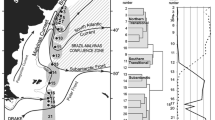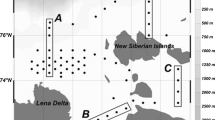Abstract
The quantitative and qualitative distribution of phytoplankton was investigated along five North–South transects in the eastern Weddell Sea during the transition from late autumn to winter. Relationships with the regional hydrography, progressing sea ice coverage, nutrient distribution and zooplankton are discussed and compared with data from other seasons. To the north of the Antarctic Slope Front (ASF) a remnant temperature minimum layer was found above the primary pycnocline throughout summer. Surface waters had not entirely acquired typical winter characteristics. While temperature was already in the winter range, this was not the case for salinity. Highest biomass of phytoplankton, with the exception of the first transect, was found in the region adjoining the ASF to the north. Absolute chlorophyll a (Chl a) concentrations dropped from 0.35 to 0.19 μg l−1 . Nutrient pools exhibited a replenishing tendency. Ammonium concentrations were high (0.75–2 μmol l−1), indicating extensive heterotrophic activity. The phytoplankton in the ASF region was dominated by nanoflagellates, particularly Phaeocystis spp.. North of the ASF the abundance of diatoms increased, with Fragilariopsis spp., F. cylindrus and Thalassiosira spp. dominating. Community structure varied both due to hydrographical conditions and the advancing ice edge. The phytoplankton assemblage formed during late autumn were very similar to the ones found in early spring. A POC/PON ratio close to Redfield, decreasing POC concentration and a high phaeophytin/Chl a ratio, as well as a high abundance of mesozooplankton indicated that a strong grazing pressure was exerted on the phytoplankton community. A comparison between primary production (PP) in the water column and the sea ice showed a shift of the major portion of PP into the ice during the period of investigation.










Similar content being viewed by others
References
Ainley DG, Jacobs SJ (1981) Sea-bird affinities for ocean and ice boundaries in the Antarctic. Deep Sea Res 28A:1173–1185
Arrigo KR, Robinson DH, Worthen DL, Dunbar RB, DiTullio GR, VanWoert M, Lizotte MP (1999) Phytoplankton community structure and the drawdown of nutrients and CO2 in the Southern Ocean. Science 283:365–367
Bathmann UV, Scharek R, Klaas C, Dubischar CD, Smetacek V (1997) Spring development of phytoplankton biomass and composition in major water masses of the Atlantic sector of the Southern Ocean. Deep Sea Research Part II: Topical Studies in Oceanography 44:51–67
Bellerby RGJ, Hoppema M, Fahrbach E, de Baar HJW, Stoll MHCMHC (2004) Interannual controls on Weddell Sea surface water fCO2 during the autumn-winter transition phase. Deep Sea Research Part I: Oceanographic Research Papers 51:793–808
Biggs DC (1982) Zooplankton excretion and NH4 cycling in near-surface waters of the Southern Ocean 1. Ross Sea, austral summer 1977–1978. Polar Biology 1:55–67
von Bodungen B, Nöthig EM, Sui Q (1988) New production of phytoplankton and sedimentation during summer 1985 in the southeastern Weddell Sea. Comp Biochem Physiol B: Comp Biochem 90B:475–487
Boyd PW, Robinson C, Savidge GJ, Williams PJ (1995) Water colomn and sea ice primary production during austral spring in the Bellingshausen Sea. Deep Sea Research Part II: Topical Studies in Oceanography 42:1177–1200
Bray JR, Curtis JT (1957) An ordination of the upland forest communities of southern Wisconsin. Ecological Monographs 27:325–349
Carmack E (1974) A quantitative charactarization of water masses in the Weddell Sea during summer. Deep Sea Res 21:431–443
Carmack E, Foster TD (1977) Water masses and circulation in the Weddell Sea. In: Dunbar M (ed) Polar Oceans. Arktic Institut of North America, Calgary, Canada, pp 151–166
Dower KM, Lucas MI, Phillips R, Dieckmann G, Robinson DH (1996) Phytoplankton biomass, P-I relationships and primary production in the Weddell Sea, Antarctica, during the austral autumn. Polar Biology 16:41–52
Estrada M, Delgado M (1989) Summer phytoplankton distributions in the Weddell Sea. Polar Biology 10:441–449
Evans CA, O’Reilly JE, Thomas JP (1987) A handbook for the measurement of chlorophyll a and primary production. Biological Investigations Of Marine Antarctic Systems and Stocks (BIOMASS). Texas A & M University, College Station, Texas
Fahrbach E, Rohardt G, Krause G (1992) The Antarctic Coastal Current in the southeastern Weddell Sea. Polar Biology 12:171–182
Foster TD, Carmack EC (1976) Frontal zone mixing and Antarctic Bottom Water formation in the southern Weddell Sea. Deep Sea Res 23:301–317
Garrison DL, Buck KR, Gowing MM (1993) Winter plankton assemblage in the ice edge zone of the Weddell and Scotia Seas: Composition, biomass and spatial distributions. Deep Sea Research Part I: Oceanographic Research Papers 40:311–338
Gleitz M, Thomas DN (1993) Variation in phytoplankton standing stock, chemical composition and physiology during sea-ice formation in the southeastern Weddell Sea, Antarctica. J Exp Mar Bio Ecol 173:211–230
Gleitz M, Bathmann UV, Lochte K (1994) Build-up and decline of summer phytoplankton biomass in the eastern Weddell Sea, Antarctica. Polar Biology 14:413–422
Grasshoff K, Ehrhardt M, Kremling K (1983) Methods of sea water analysis. Verlag Chemie, Weinheim
Hegseth EN (1997) Phytoplankton of the Barents Sea – the end of a growth season. Polar Biology 17:235–241
Hegseth EN, von Quillfeldt CH (2002) Low phytoplankton biomass and ice algal blooms in the Weddell Sea during the ice-filled summer of 1997. Antarctic Science 14:231–243
Heywood KJ, Locarnini RA, Frew RD, Dennis PF, King BA (1998) Transport and water masses of the Antarctic Slope Front system in the eastern Weddell Sea. In: Jacobs SS, Weiss RF (eds) Ocean, ice, and atmosphere: interactions at the antarctic continental margin, vol. 75, pp 203–214
Jacobs SS (1991) On the nature and significance of the Antarctic Slope. Front. Mar Chem 35:9–24
Kattner G, Becker H (1991) Nutrients and organic nitrogenous compounds in the marginal ice zone of the Fram Strait. J Mar Syst 2:385–394
Kattner G, Thomas DN, Haas C, Kennedy H, Dieckmann GS (2004) Surface ice and gap layers in Antarctic sea ice: highly productive habitats. Mar Ecol Prog Ser 277:1–12
Lange MA, Ackley SF, Wadhams P, Dieckmann G, Eicken H (1989) Developement of sea ice in the Weddell Sea. Ann Glaciol 12:92–96
Laubscher RK, Perissinotto R, McQuaid CD (1993) Phytoplankton production and biomass at frontal zones in the Atlantic sector of the Southern Ocean. Polar Biology 13:471–481
Mock T, Kroon BMA (2002) Photosynthetic energy conversion under extreme conditions–II: the significance of lipids under light limited growth in Antarctic sea ice diatoms. Phytochemistry 61:53–60
National Snow and Ice Data Center (1992) DMSP SSM/I brightness temperatures and sea ice concentration grids for the polar regions, 1992. National Snow and Ice Data Center, Distributed Active Archive Center Digital data available from nsidc@kryos.colorado.edu
Nöthig EM (1988) On the ecology of the phytoplankton in the southeastern Weddell Sea (Antarctica) in January/February 1985. Rep Polar Res 53:118
Nöthig EM, Bathmann U, Jennings JC, Fahrbach E, Gradinger R, Gordon LI, Makarov R (1991) Regional relationships between biological and hydrographical properties in the Weddell Gyre in late austral winter 1989. Mar Chem 35:325–336
Pollard RT, Read JF, Allen JT, Griffiths G, Morrison AI (1995) On the physical structure of a front in the Bellingshausen Sea. Deep Sea Research Part II: Topical Studies in Oceanography 42:955–982
Priddle J, Smetacek V, Bathmann U (1992) Antarctic marine primary production biogeochemical carbon cycle and climate change. Philosophical Transactions of the Royal Society of London, Series B 338:289–297
Reay D, Priddle J, Nedwell D, Whitehouse M, Ellis-Evans J, Deubert C, Connelly D (2001) Regulation by low temperature of phytoplankton growth and nutrient uptake in the Southern Ocean. Mar Ecol Prog Ser 219:51–64
Redfield A, Ketchum B, Richard F (1963) The influence of organisms on the composition of sea water. In: Hill M (ed) The sea, pp 26–77
Scharek R (1991) Development of phytoplankton during the late-winter/spring transition in the eastern Weddell Sea (Antarctica). Rep Polar Res 94:195
Scharek R, Smetacek V, Fahrbach E, Gordon LI, Rohardt G, Moore S (1994) The transition from winter to early spring in the eastern Weddell Sea, Antarctica: Plankton biomass and composition in relation to hydrography and nutrients. Deep Sea Research Part I: Oceanographic Research Papers 41:441–449
Schiel SB (1998) Die calanoiden Copepoden des östlichen Weddellmeeres, Antarktis: Saisonales Vorkommen und Lebenszyklen dominater Arten. In: Habilitationsschrift der Mathematisch-Naturwissenschaftlichen Fakultät der Christian-Albrechts Universität Kiel, p 227
Schnack-Schiel SB, Hagen W, Mizdalski E (1998) Seasonal carbon distribution of copepods in the eastern Weddell Sea. J Mar Syst 17:305–311
Schröder M, Fahrbach E (1999) On the structure and the transport of the eastern Weddell Gyre. Deep Sea Research Part II: Topical Studies in Oceanography 46:501–527
Smetacek V, Passow U (1990) Spring bloom initiation and Sverdrup’s critical-depth model. Limnol Oceanogr 35:228–234
Smetacek V, Scharek R, Nöthig EM (1990) Seasonal and regional variation in the pelagial and its relationship to the life history cycle of krill. In: Kerry K and Hempel G (eds) Antarctic ecosystems: Ecologycal change and conservation. Springer Verlag, Berlin, pp 103–114
Smetacek V, De Baar HJW, Bathmann UV, Lochte K, Van Der Loeff MMR (1997) Ecology and biogeochemistry of the Antarctic Circumpolar Current during austral spring: a summary of Southern Ocean JGOFS cruise ANT X/6 of R.V. Polarstern. Deep Sea Research Part II: Topical Studies in Oceanography 44:1–21
Smith WO, Nelson DM (1986) Importance of ice-edge production in the Southern Ocean. Bio Sci 36:251–257
Sokolov S, Rintoul SR (2002) Structure of Southern Ocean fronts at 140[deg]E. J Mar Syst 37:151–184
Spiridonov VA, Noethig EM, Schroeder M, Wisotzki A (1996) The onset of biological winter in the eastern Weddell Gyre (Antarctica) planktonic community. J Mar Syst 9:211–230
Swadling KM, Gibson JAE, Ritz DA, Nichols PD, Hughes DE (1997) Grazing of phytoplankton by copepods in eastern Antarctic coastal waters. Mar Biol 128:39–48
Tilzer MM, Dubinsky Z (1987) Effects of temperature and day length on the mass balance of Antarctic phytoplankton. Polar Biology 7:35–42
Utermöhl H (1958) Zur Vervollkommnung der quantitativen Phytoplankton-Methodik. Mitt int Ver theor angew Limnol 9:1–38
Weeks WF, Ackley SF (1982) The growth, structure and properties of sea ice. CRREL Monogr 82(1):130
Weissenberger J, Dieckmann G, Gradinger R, Spindler M (1992) Sea ice: a cast technique to examine and analyze brine pockets and channel structure. Limnol Oceanogr 37:179–183
Wright SW, van den Enden RL (2000) Phytoplankton community structure and stocks in the East Antarctic marginal ice zone (BROKE survey, January-March 1996) determined by CHEMTAX analysis of HPLC pigment signatures. Deep Sea Research Part II: Top Stud Oceanogra 47:2363–2400
Author information
Authors and Affiliations
Corresponding author
Rights and permissions
About this article
Cite this article
Krell, A., Schnack-Schiel, S.B., Thomas, D.N. et al. Phytoplankton dynamics in relation to hydrography, nutrients and zooplankton at the onset of sea ice formation in the eastern Weddell Sea (Antarctica). Polar Biol 28, 700–713 (2005). https://doi.org/10.1007/s00300-005-0733-6
Received:
Revised:
Accepted:
Published:
Issue Date:
DOI: https://doi.org/10.1007/s00300-005-0733-6




